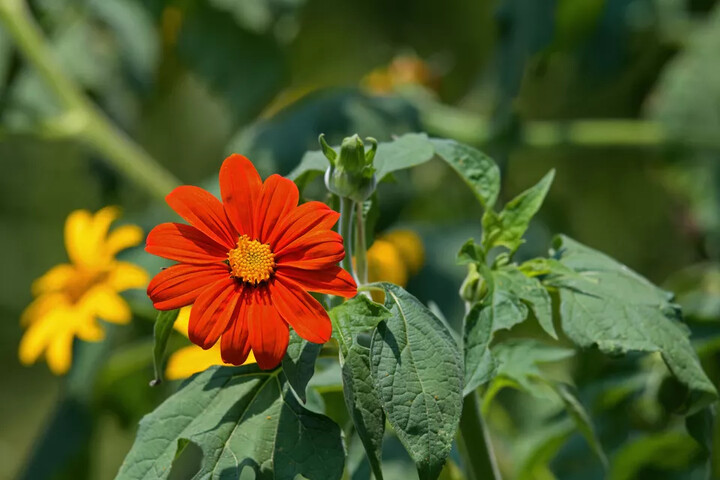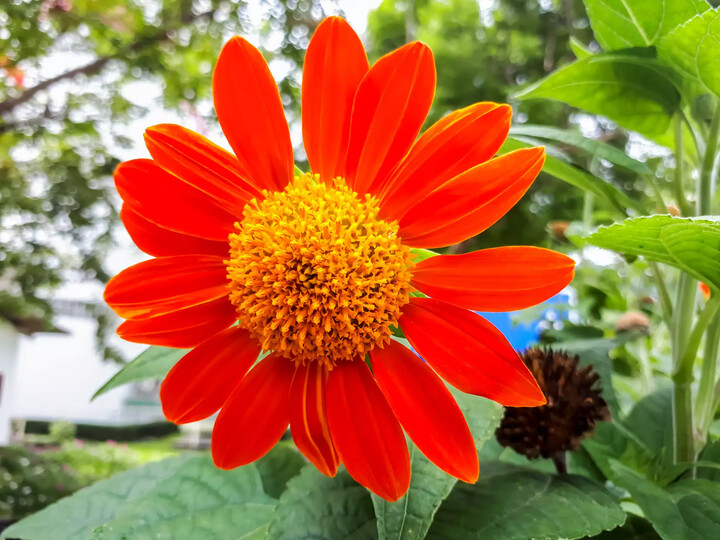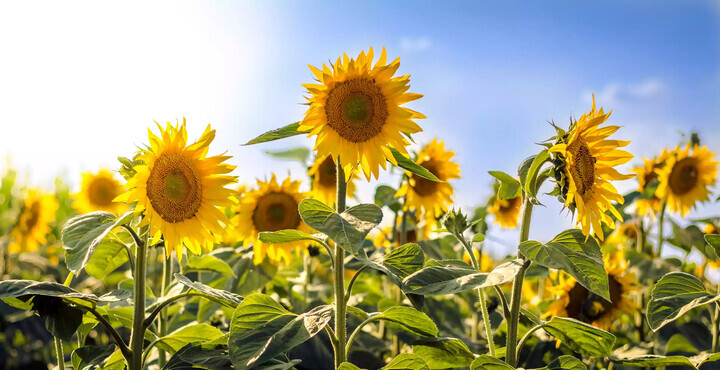At winter's end, gardeners rush to the seed aisle of the garden center, looking for something that will transform the landscape in a few month's time. The Mexican sunflower is on the short list of annuals that leap to shoulder-height and beyond when temperatures heat up, asking for little care in return. Mexican sunflowers yield dozens of daisy-like blooms for cut flower arrangements, while producing enough to attract scores of butterflies and beneficial insects like parasitic wasps.
| Botanical Name | Tithonia rotundifolia |
|---|---|
| Common Name | Mexican Sunflower, tree marigold |
| Plant Type | Annual |
| Mature Size | Three to eight feet |
| Sun ExposureSoil | Type Average to poor |
| Soil pH | Acidic; 5.8-6.5 |
| Bloom Time | Summer and fall |
| Flower Color | Yellow and dark orange |
| Hardiness Zones | 9 to 11 |
| Native Area | Mexico and Central America |

How to Grow Mexican Sunflowers
Mexican sunflowers are ideal for the beginner gardener who wants something showy to fill in a large blank spot in the flower border. Mexican sunflowers aren’t fussy about soil, and don’t need much care after they get growing.
Mexican sunflowers are a welcome addition to the butterfly garden, as they have the nectar rich stores in shallow blossoms that meet a pollinator’s needs. Unlike many butterfly-friendly plants that are small in stature, the tall blooms of the Mexican sunflower bring butterflies right up to eye level, making them easier to observe. A mature stand of Mexican sunflowers makes a good addition to the vegetable garden, as the pollinators they attract will help increase your vegetable yields.
One packet of Mexican sunflowers will give you many vasefuls of cut flowers throughout the summer. Plant them with companions that thrive in the same sunny site and average soil, like cosmos and zinnias, which will also act as cut-and-come-again blooms for the cutting garden.
Light
Full sun is a critical factor in growing healthy Mexican sunflowers. Plants growing in shady areas may not bloom, will flop over, and might suffer from fungal diseases.
Soil
Save your soil amendments for fussier flowers like roses and dahlias, because Mexican sunflowers like lean soils with a low nutrient content. Good drainage is important, to prevent problems like root rot. Sandy or rocky soils more closely resemble the native soils of Mexico where the plants grow wild.
Water
Mexican sunflowers are drought tolerant throughout their life cycle, contributing to their low maintenance charm. Wet soil is not tolerated by Mexican sunflowers, but if your area gets more rain than average, you can compensate for this by planting in soil with excellent drainage.
Temperature and Humidity
Mexican sunflowers love hot weather, even days with triple digit temperatures. Conversely, cool weather stops the Mexican sunflower in its tracks. When nighttime temperatures are in the 60’s, it’s the right time to grow Mexican sunflowers. Average humidity is best for healthy plants. Provide extra spacing for plants in humid areas to prevent powdery mildew.
Fertilizer
Mexican sunflowers grow just fine without any supplemental fertilizer. In areas with especially depleted soils, you can add an all-purpose flower fertilizer at the beginning of the season to get plants off to a quick start.
Potting and Repotting
Because of its large size and rapid growth, plant no more than a few Mexican sunflowers in a container. Sow seeds directly in the pot, as large plants are difficult to transplant. Use a soilless potting mix with good drainage.
Propagating Mexican Sunflower
Although Mexican sunflower is easy to grow from seed, if you can’t find your favorite variety you can also propagate plants by stem cuttings. Take two or three inch stem pieces, and remove all but one pair of leaves. Cut the remaining leaves in half, as they are too large to be supported by the cutting. Insert in moist potting soil, and expect roots to form in about 10 days.
Varieties of Mexican Sunflower
‘Torch’ is the mainstay of Mexican sunflowers, growing in gardens since the 1950’s. ‘Fiesta del Sol’ and ‘Goldfinger’ are dwarf varieties for smaller gardens or containers, growing between two and three feet tall.

Toxicity of Mexican Sunflower
According to the California Poison Control System, Mexican sunflowers are non-toxic to cats and dogs.
Pruning
Pruning Mexican sunflowers isn’t necessary, but can help to get lanky plants under control or to keep overgrown plants in bounds. Keep in mind that you may sacrifice some blooms when pruning. Cut off the top one-third of the plant when it’s experiencing a lull in blooming to both deadhead and tidy the plant.
Being Grown in Containers
Gardeners with small plots can grow dwarf varieties of Mexican sunflower on the patio, deck, or balcony. Plant the Mexican sunflower in the center of the pot, and add trailing plants like million bells or portulaca, which also appreciate full sun and dry conditions.
Growing From Seeds
The small, triangular seeds of Mexican sunflower germinate easily in warm, moist soil. The quickest approach is to sow the seeds outdoors, at the same time you plant tomatoes, two weeks after the last frost. In short summer areas, zone 4 and colder, start the seeds indoors six weeks before last frost to ensure the plants have time to mature and bloom before fall.
Common Pests/Diseases
Snails and slugs sometimes bother Mexican sunflowers, especially in rainy weather. Place a piece of damp cardboard beside plants, and collect the pests when they hide during daylight hours.
Mexican Sunflowers vs. Sunflowers
Mexican sunflowers and common sunflowers (Helianthus annuus) are both tall, sun-loving annual flowers that tolerate dry and poor soils. Common sunflowers usually have larger blooms, sometimes in excess of 12 inches in diameter, and many varieties also have edible seeds. Grow the two complimentary sunflower plants at the back of the border for a visual and pollinator feast.
